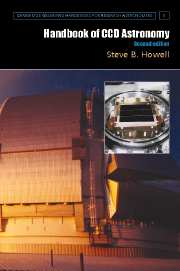Book contents
- Frontmatter
- Contents
- Preface to the first edition
- Preface to the second edition
- 1 Introduction
- 2 CCD manufacturing and operation
- 3 Characterization of charge-coupled devices
- 4 CCD imaging
- 5 Photometry and astrometry
- 6 Spectroscopy with CCDs
- 7 CCDs used in space and at short wavelengths
- Appendices
- References
- Index
7 - CCDs used in space and at short wavelengths
Published online by Cambridge University Press: 05 June 2012
- Frontmatter
- Contents
- Preface to the first edition
- Preface to the second edition
- 1 Introduction
- 2 CCD manufacturing and operation
- 3 Characterization of charge-coupled devices
- 4 CCD imaging
- 5 Photometry and astrometry
- 6 Spectroscopy with CCDs
- 7 CCDs used in space and at short wavelengths
- Appendices
- References
- Index
Summary
The current high level of understanding of CCDs in terms of their manufacture, inherent characteristics, instrumental capabilities, and data analysis techniques make these devices desirable for use in spacecraft and satellite observatories and at wavelengths other than the optical. Silicon provides at least some response to photons over the large wavelength range from about 1 to 10 000 Å. Figure 7.1 shows this response by presenting the absorption depth of silicon over an expanded wavelength range. Unless aided in some manner, the intrinsic properties of silicon over the UV and EUV spectral range (1000–3000 Å) are such that the QE of the device at these wavelengths is typically only a few percent or less. This low QE value is due to the fact that for these very short wavelengths, the absorption depth of silicon is near 30–50 Å, far less than the wavelength of the incident light itself. Thus, the majority of the light (~ 70%) is reflected with the remaining percentage passing directly through the CCD unhindered.
Observations at wavelengths shorter than about 3000 Å involve additional complexities not encountered with ground-based optical observations. Access to these short wavelengths can only be obtained via space-based telescopes or high altitude rocket and balloon flights. The latter are of short duration from only a few hours up to possibly hundreds of days and use newly developing high-altitude ultra-long duration balloon flight technologies.
- Type
- Chapter
- Information
- Handbook of CCD Astronomy , pp. 167 - 185Publisher: Cambridge University PressPrint publication year: 2006

